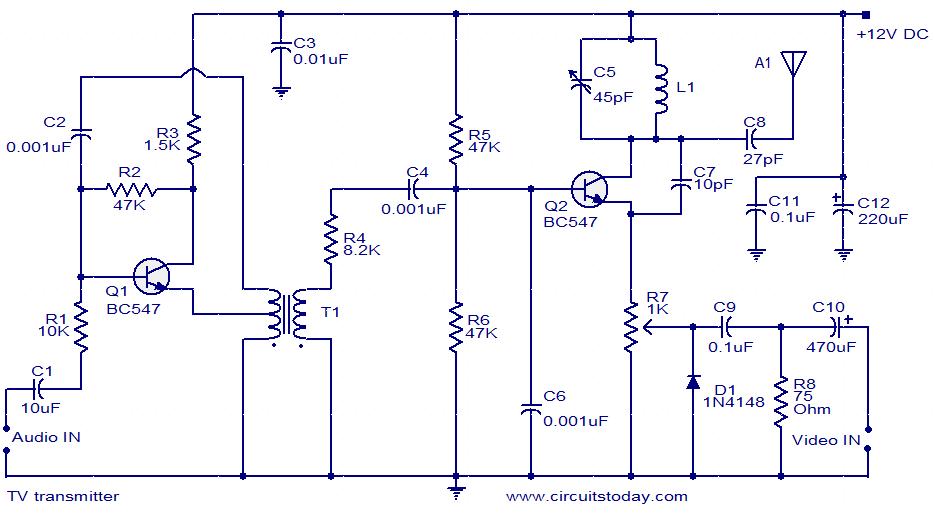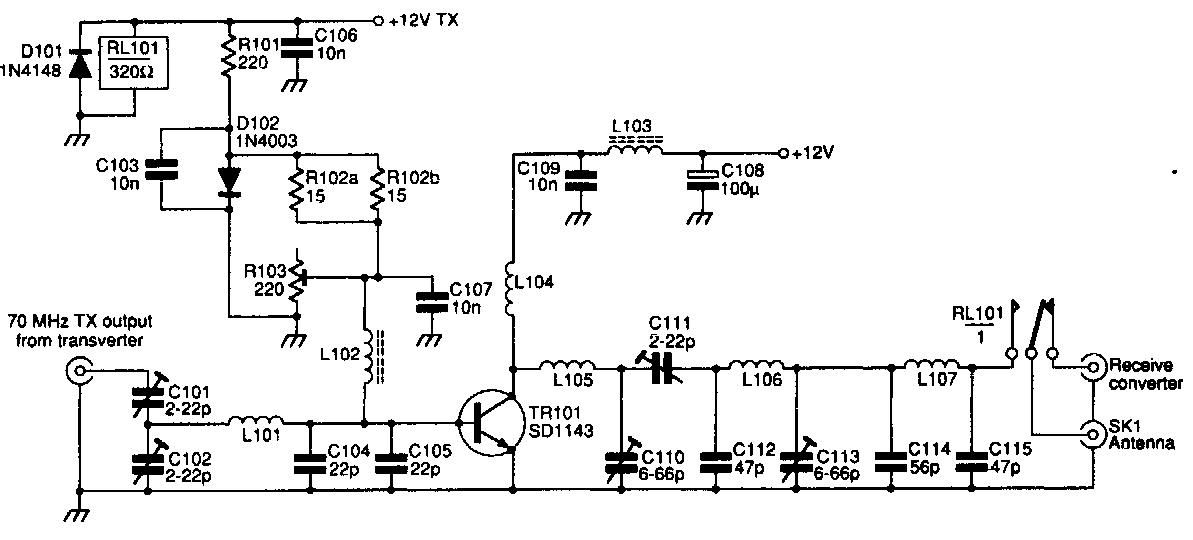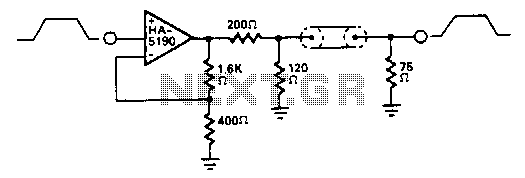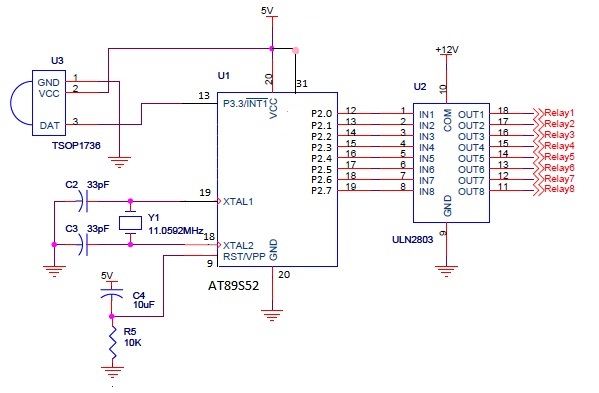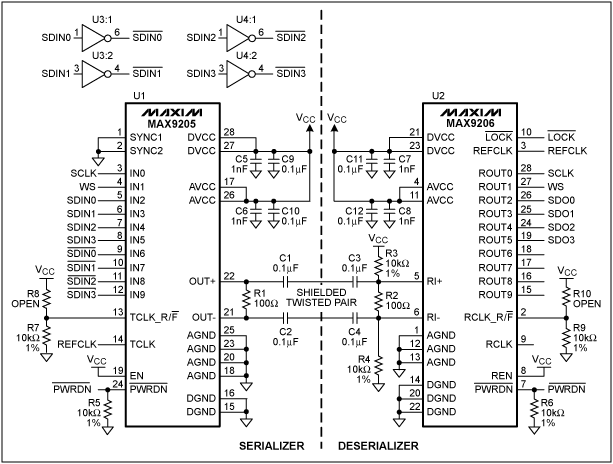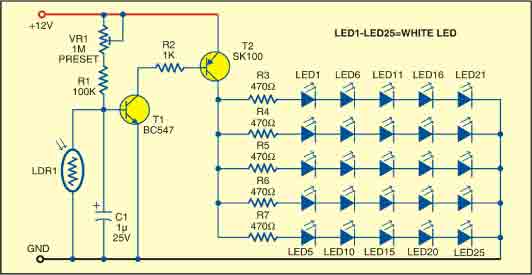
video signal amplifier using with lh0024
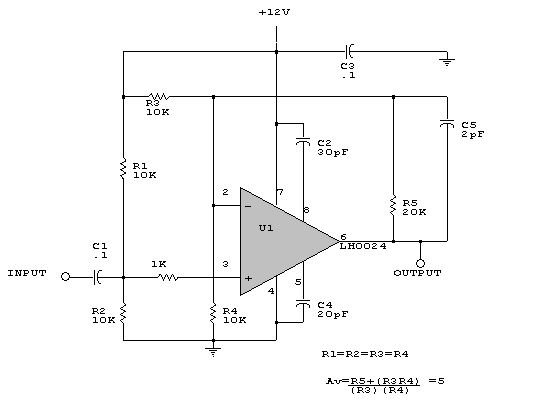
The LH0024 is a small signal integrated circuit (IC) designed for general-purpose switching and amplification due to its low voltage characteristics. Additionally, it utilizes three 1N4148 silicon small signal diodes, which are planar epitaxial devices used for fast switching applications, featuring a reverse voltage rating of 100 V and a forward current rating of 150 mA. In a video output signal application, this IC can achieve a high frame rate for amplification. The circuit can be constructed by placing a track between the video device and the reception area, where the video port of the television receiver is connected. The design incorporates three transistors instead of an IC and other supporting components. An isolator is employed in the first phase using transistor Q1, which provides an interface for input impedance. The second phase, managed by Q2, utilizes a common base configuration to determine the gain, with a resistor TR2 set to 250 ohms. To adjust TR2, it is necessary to achieve an output voltage of 1 Vp-p with a load of 75 ohms. The frequency response is regulated by a combination of resistors R6, capacitor C3, and a variable resistor TR1 set to 500 ohms. The third phase is completed by Q3, which serves as an output buffer providing a 75-ohm output. The circuit operates with a stabilized power supply of 12 V and a current rating of 50 mA.
The LH0024 integrated circuit serves as a versatile component in various electronic applications, particularly in signal processing where amplification and switching are required. It is particularly well-suited for video signal amplification due to its ability to handle low voltage operations efficiently. The use of the 1N4148 diodes enhances the circuit's capability for fast switching, making it ideal for high-speed applications.
In the circuit design, the first stage with Q1 functions as an isolator, ensuring that the input signal does not load the source. This is critical in maintaining signal integrity, especially in video applications where high fidelity is essential. The second stage, utilizing Q2 in a common base configuration, is crucial for achieving the desired gain. The gain setting through TR2 allows for fine-tuning of the output to match the requirements of the connected load, ensuring optimal performance.
The frequency response of the circuit is carefully controlled using a combination of resistors and capacitors. R6 and C3 are selected to provide the necessary bandwidth while TR1 allows for additional adjustments, ensuring that the circuit can handle the frequency range of the video signals without distortion.
The final stage, represented by Q3, acts as a buffer to provide a stable output to the load, which is essential for maintaining signal quality when interfacing with other devices such as television receivers. The output impedance of 75 ohms is standard for video applications, ensuring compatibility with most video equipment.
Overall, the design is robust, with a power supply requirement of 12 V and a current draw of 50 mA, making it suitable for integration into various electronic devices where video signal processing is required.LH0024 IC small signal IC designed for general purpose switching and amplification due to its low voltage, low voltage and three different win the election 1N4148 silicon small signal diode planar epitaxial used for fast switching applications with a reverse voltage of 100 V and forward current of 150 mA In a video output signal is the high rate of frames selected for amplification of producing a finer. This is possible by placing the track between the video device and the reception lobby, where the video port of the television receiver is inserted. The construction is done simply by exploiting the operation of three transistors instead of IC and other supporting elements.
An isolator operating in the first phase of the Q1, which provides an interface for input impedance. Q2 manage the second phase, which leads to the common base configuration. In this phase, determine the earnings TR2 250 ohms cutting the lawn. To adjust TR2, it must be placed where an output voltage of 1 Vp-p is present, with a load of 75 ohms. The frequency response is regulated by a combination of R6, C3, and 500 ohms TR1. An output buffer is completed by Q3 of the third phase which provides an airline pilot with 75 ohms. The range of the circuit is stabilized with 12 V and 50 mA. 🔗 External reference
The LH0024 integrated circuit serves as a versatile component in various electronic applications, particularly in signal processing where amplification and switching are required. It is particularly well-suited for video signal amplification due to its ability to handle low voltage operations efficiently. The use of the 1N4148 diodes enhances the circuit's capability for fast switching, making it ideal for high-speed applications.
In the circuit design, the first stage with Q1 functions as an isolator, ensuring that the input signal does not load the source. This is critical in maintaining signal integrity, especially in video applications where high fidelity is essential. The second stage, utilizing Q2 in a common base configuration, is crucial for achieving the desired gain. The gain setting through TR2 allows for fine-tuning of the output to match the requirements of the connected load, ensuring optimal performance.
The frequency response of the circuit is carefully controlled using a combination of resistors and capacitors. R6 and C3 are selected to provide the necessary bandwidth while TR1 allows for additional adjustments, ensuring that the circuit can handle the frequency range of the video signals without distortion.
The final stage, represented by Q3, acts as a buffer to provide a stable output to the load, which is essential for maintaining signal quality when interfacing with other devices such as television receivers. The output impedance of 75 ohms is standard for video applications, ensuring compatibility with most video equipment.
Overall, the design is robust, with a power supply requirement of 12 V and a current draw of 50 mA, making it suitable for integration into various electronic devices where video signal processing is required.LH0024 IC small signal IC designed for general purpose switching and amplification due to its low voltage, low voltage and three different win the election 1N4148 silicon small signal diode planar epitaxial used for fast switching applications with a reverse voltage of 100 V and forward current of 150 mA In a video output signal is the high rate of frames selected for amplification of producing a finer. This is possible by placing the track between the video device and the reception lobby, where the video port of the television receiver is inserted. The construction is done simply by exploiting the operation of three transistors instead of IC and other supporting elements.
An isolator operating in the first phase of the Q1, which provides an interface for input impedance. Q2 manage the second phase, which leads to the common base configuration. In this phase, determine the earnings TR2 250 ohms cutting the lawn. To adjust TR2, it must be placed where an output voltage of 1 Vp-p is present, with a load of 75 ohms. The frequency response is regulated by a combination of R6, C3, and 500 ohms TR1. An output buffer is completed by Q3 of the third phase which provides an airline pilot with 75 ohms. The range of the circuit is stabilized with 12 V and 50 mA. 🔗 External reference
